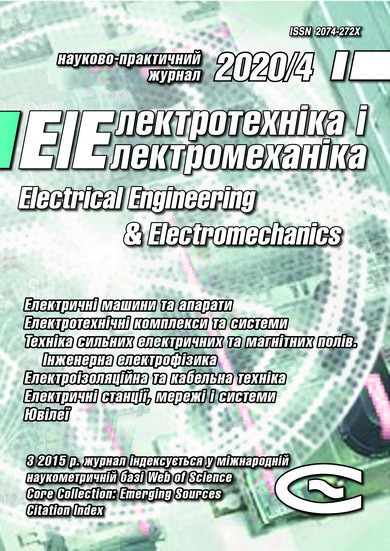INCREASING NOISE IMMUNITY OF CABLES FOR FIRE PROTECTION SYSTEMS
DOI:
https://doi.org/10.20998/2074-272X.2020.4.07Keywords:
fire protection systems, electromagnetic influence, near end crosstalk, twisted pairs, unshielded and shielded cables, attenuation coefficientAbstract
Introduction. Technical means of fire protection systems are capable of operating at data rates from tens to hundreds of Kbit/s with components of a digital signal in the frequency spectrum up to several tens of MHz. Appropriate cable infrastructure with a high level of noise immunity is required to transmit broadband digital signals. Purpose. Substantiation of ways to increase noise immunity of cables based on twisted pairs for modern fire protection systems with the ability to transmit digital signals in the frequency spectrum up to 100 MHz. Methodology. A comparison is made of the influence of the twisting step of pairs in unshielded 4-pair and multi-pair shielded balanced cables on the parameters of electromagnetic effects. It has been experimentally shown that twisting each pair with different steps provides a higher level of noise immunity of cables based on twisted pairs. Practical value. The frequency dependencies of the near end crosstalk in 10-, 30- and 4-pair balanced cables are shown. The influence of the common shield on the attenuation coefficient of the shielded 4-pair cable is established.References
Pigan R., Metter M. Automating with PROFINET: Industrial Communication Based on Industrial Ethernet. John Wiley & Sons Publ., 2015. 462 p.
Belous A., Saladukha V. High-Speed Digital System Design: Art, Science and Experience. Springer Nature Publ., 2019. 933 p.
Catalog Nexans. Cables for alarm and safety systems. 2018. 16 p.
International Standard ISO/IEC 11801. Information Technology – Generic cabling for customer premises. Part 2: Office premises. 2017. 24 p.
Penttinen Jyrki T.J. The Telecommunications Handbook: Engineering Guidelines for Fixed, Mobile and Satellite Systems. John Wiley & Sons Publ., 2015. 1008 p.
Weston David A. Electromagnetic Compatibility: Methods, Analysis, Circuits, and Measurement. CRC Press, 3rd Edition, 2016. 1160 p.
Solak V., Efendioglu H.S., Colak B., Garip M. Analysis and simulation of cable crosstalk. IEEE IV International Electromagnetic Compatibility Conference (EMC Turkey), 24-27 Sept. 2017, Ankara, Turkey, pp 1-4. doi: 10.1109/EMCT.2017.8090354.
Bezprozvannych G.V., Ignatenko A.G. The influence of core twisting on the transmission parameters of network cables. Bulletin of NTU «KhPI», 2004, no.7, pp. 82-87. (Rus).
Bezprozvannych G.V., Ignatenko A.G. Optimization of the design of network cables by the attenuation coefficient in the tolerance zone of the geometric dimensions of the transmission parameters. Electrical engineering & electromechanics, 2004, no. 2. pp. 8-10. (Rus).
Boyko AM, Bezprozvannych G.V. Justification of insulation thickness of twisted shielded pairs of structured cable systems. Bulletin of NTU «KhPI», 2011, no. 3, pp. 21-35. (Ukr).
Bezprozvannych G.V., Ignatenko A.G. Indirect estimates of tolerances on the diameters of conductive conductors of twisted pair conductors of network cables. Bulletin of NTU «KhPI», 2005, no. 42, pp. 47-52. (Rus).
Baltag O., Rosu G., Rau M.C. Magnetic field of parallel and twisted wire pairs. 2017 10th International Symposium on Advanced Topics in Electrical Engineering (ATEE), 2017, pp. 324-329. doi: 10.1109/atee.2017.7905020.
Downloads
Published
How to Cite
Issue
Section
License
Copyright (c) 2020 G. V. Bezprozvannych, O. A. Pushkar

This work is licensed under a Creative Commons Attribution-NonCommercial 4.0 International License.
Authors who publish with this journal agree to the following terms:
1. Authors retain copyright and grant the journal right of first publication with the work simultaneously licensed under a Creative Commons Attribution License that allows others to share the work with an acknowledgement of the work's authorship and initial publication in this journal.
2. Authors are able to enter into separate, additional contractual arrangements for the non-exclusive distribution of the journal's published version of the work (e.g., post it to an institutional repository or publish it in a book), with an acknowledgement of its initial publication in this journal.
3. Authors are permitted and encouraged to post their work online (e.g., in institutional repositories or on their website) prior to and during the submission process, as it can lead to productive exchanges, as well as earlier and greater citation of published work.





